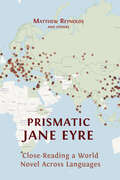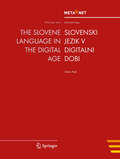- Table View
- List View
Prismatic Jane Eyre: Close-Reading a World Novel Across Languages
by Matthew Reynolds OthersJane Eyre, written by Charlotte Brontë and first published in 1847, has been translated more than five hundred times into over sixty languages. Prismatic Jane Eyre argues that we should see these many re-writings, not as simple replications of the novel, but as a release of its multiple interpretative possibilities: in other words, as a prism. Prismatic Jane Eyre develops the theoretical ramifications of this idea, and reads Brontë’s novel in the light of them: together, the English text and the many translations form one vast entity, a multilingual world-work, spanning many times and places, from Cuba in 1850 to 21st-century China; from Calcutta to Bologna, Argentina to Iran. Co-written by many scholars, Prismatic Jane Eyre traces the receptions of the novel across cultures, showing why, when and where it has been translated (and no less significantly, not translated – as in Swahili), and exploring its global publishing history with digital maps and carousels of cover images. Above all, the co-authors read the translations and the English text closely, and together, showing in detail how the novel’s feminist power, its political complexities and its romantic appeal play out differently in different contexts and in the varied styles and idioms of individual translators. Tracking key words such as ‘passion’ and ‘plain’ across many languages via interactive visualisations and comparative analysis, Prismatic Jane Eyre opens a wholly new perspective on Brontë’s novel, and provides a model for the collaborative close-reading of world literature. Prismatic Jane Eyre is a major intervention in translation and reception studies and world and comparative literature. It will also interest scholars of English literature, and readers of the Brontës.
Prismatic Jane Eyre: Close-Reading a World Novel Across Languages
by Matthew Reynolds OthersJane Eyre, written by Charlotte Brontë and first published in 1847, has been translated more than five hundred times into over sixty languages. Prismatic Jane Eyre argues that we should see these many re-writings, not as simple replications of the novel, but as a release of its multiple interpretative possibilities: in other words, as a prism. Prismatic Jane Eyre develops the theoretical ramifications of this idea, and reads Brontë’s novel in the light of them: together, the English text and the many translations form one vast entity, a multilingual world-work, spanning many times and places, from Cuba in 1850 to 21st-century China; from Calcutta to Bologna, Argentina to Iran. Co-written by many scholars, Prismatic Jane Eyre traces the receptions of the novel across cultures, showing why, when and where it has been translated (and no less significantly, not translated – as in Swahili), and exploring its global publishing history with digital maps and carousels of cover images. Above all, the co-authors read the translations and the English text closely, and together, showing in detail how the novel’s feminist power, its political complexities and its romantic appeal play out differently in different contexts and in the varied styles and idioms of individual translators. Tracking key words such as ‘passion’ and ‘plain’ across many languages via interactive visualisations and comparative analysis, Prismatic Jane Eyre opens a wholly new perspective on Brontë’s novel, and provides a model for the collaborative close-reading of world literature. Prismatic Jane Eyre is a major intervention in translation and reception studies and world and comparative literature. It will also interest scholars of English literature, and readers of the Brontës.
The Slovene Language in the Digital Age (White Paper Series)
by Georg Rehm Hans UszkoreitThis white paper is part of a series that promotes knowledge about language technology and its potential. It addresses educators, journalists, politicians, language communities and others. The availability and use of language technology in Europe varies between languages. Consequently, the actions that are required to further support research and development of language technologies also differ for each language. The required actions depend on many factors, such as the complexity of a given language and the size of its community. META-NET, a Network of Excellence funded by the European Commission, has conducted an analysis of current language resources and technologies. This analysis focused on the 23 official European languages as well as other important national and regional languages in Europe. The results of this analysis suggest that there are many significant research gaps for each language. A more detailed expert analysis and assessment of the current situation will help maximise the impact of additional research and minimize any risks. META-NET consists of 54 research centres from 33 countries that are working with stakeholders from commercial businesses, government agencies, industry, research organisations, software companies, technology providers and European universities. Together, they are creating a common technology vision while developing a strategic research agenda that shows how language technology applications can address any research gaps by 2020.

